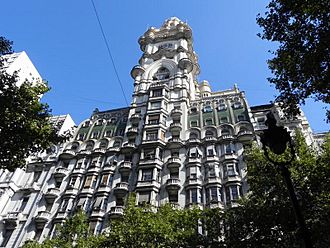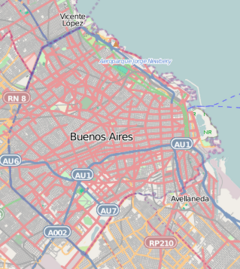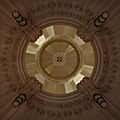Palacio Barolo facts for kids
Quick facts for kids Palacio BaroloBarolo Palace |
|
|---|---|

|
|
| General information | |
| Type | Office Building |
| Architectural style | Art Nouveau, Art Deco, Eclecticism, Gothic |
| Location | Monserrat, Buenos Aires, Argentina |
| Address | Avenida de Mayo 1370 |
| Construction started | 1919 |
| Completed | 1923 |
| Height | 100 metres |
| Technical details | |
| Floor count | 22 |
| Design and construction | |
| Architect | Mario Palanti |
| Main contractor | Wayss & Freytag |
| Designated: | 1989 |
The Palacio Barolo is a famous office building in Buenos Aires, Argentina. You can find it at 1370 Avenida de Mayo. For over ten years, it was the tallest building in Buenos Aires. It held this title until the Kavanagh Building was finished in 1936. The Palacio Barolo has a "twin brother" building called Palacio Salvo in Montevideo, Uruguay. Both were designed by the same architect.
This amazing building was named a national historic monument in 1997. Today, it houses many different businesses. You can find travel agencies, a Spanish school for people from other countries, and a shop that sells tango clothes. There are also offices for architects, accountants, lawyers, and designers.
Building History
An Italian architect named Mario Palanti was asked to design the Palacio Barolo. The person who asked him was Luis Barolo. Luis Barolo was an Italian immigrant who came to Argentina in 1890. He became very rich by making knitted fabrics. The basic idea for the Palacio Barolo was created at the same time as the design for the Palacio Salvo in Montevideo, Uruguay.
The Palacio Barolo was designed with a special idea in mind. It was based on the story of Dante's Divine Comedy. The architect, Mario Palanti, really admired the writer Dante Alighieri. The building has 22 floors, which are split into three main parts. The basement and ground floor represent "hell." Floors 1 to 14 are like "purgatory." And floors 15 to 22 represent "heaven." The building is 100 meters (about 328 feet) tall. This is special because it's one meter for each canto (a section or chapter) of the Divine Comedy. The bright light at the very top of the building can even be seen from Montevideo, Uruguay! Luis Barolo, the owner, originally planned to use only three floors himself and rent out the rest.
When the building was finished in 1923, it was the tallest building not just in Buenos Aires, but in all of South America. It stayed the city's tallest building until 1935. That's when the Kavanagh Building was completed and became taller. Today, the Palacio Barolo is mainly used for lawyers' offices, a school to learn Spanish, and a shop that sells clothes for Tango dancing.
Amazing Design Details
This tall building is 100 meters (about 328 feet) high and has 22 floors. Each floor has its own special design and decorations. Following the idea of the Divine Comedy, the bright light at the top of the building stands for the nine groups of angels. The very top of the building has a small spire. This spire has a decoration that looks like the Southern Cross constellation in the sky.
The building's base was designed using the golden ratio. This is a special mathematical idea found often in nature and art. The Palacio Barolo was even built with the idea of holding Dante's ashes! Barolo believed that Europe was heading for trouble. He wanted to keep Dante's ashes as far away from Europe as possible.
The main entrance area, called the lobby, has a central hall. It is decorated with words in Latin and statues of strange creatures. From a central dome, nine arched walkways spread out. These arches represent the nine circles of hell described in Dante's Inferno. The first three floors have shapes that stand for fire. They also show the colors of the Italian flag and various Masonic symbols on the walls and floors. The lobby also has old-fashioned elevators that still work!
The lighthouse on top of the Palacio Barolo was designed to work with the Palacio Salvo in Montevideo, Uruguay. Together, they were meant to welcome visitors arriving from the Atlantic Ocean into the Rio de la Plata estuary. It was like the Pillars of Hercules in ancient times. The decorative spire at the top lines up perfectly with the real Southern Cross constellation on July 9th. This date is Argentine Independence Day.
Gallery
Historical Photos
See also
 In Spanish: Palacio Barolo para niños
In Spanish: Palacio Barolo para niños













